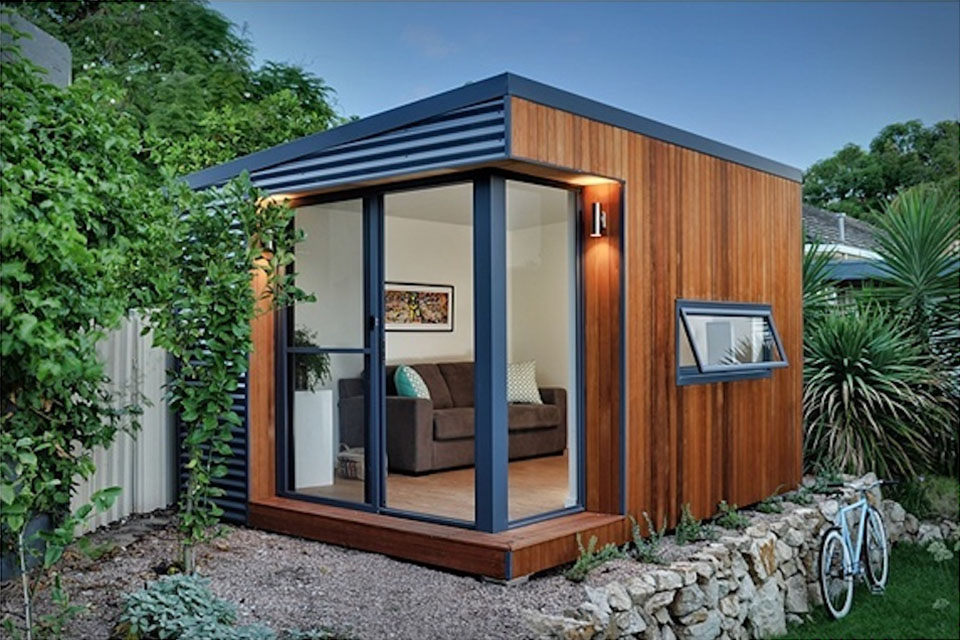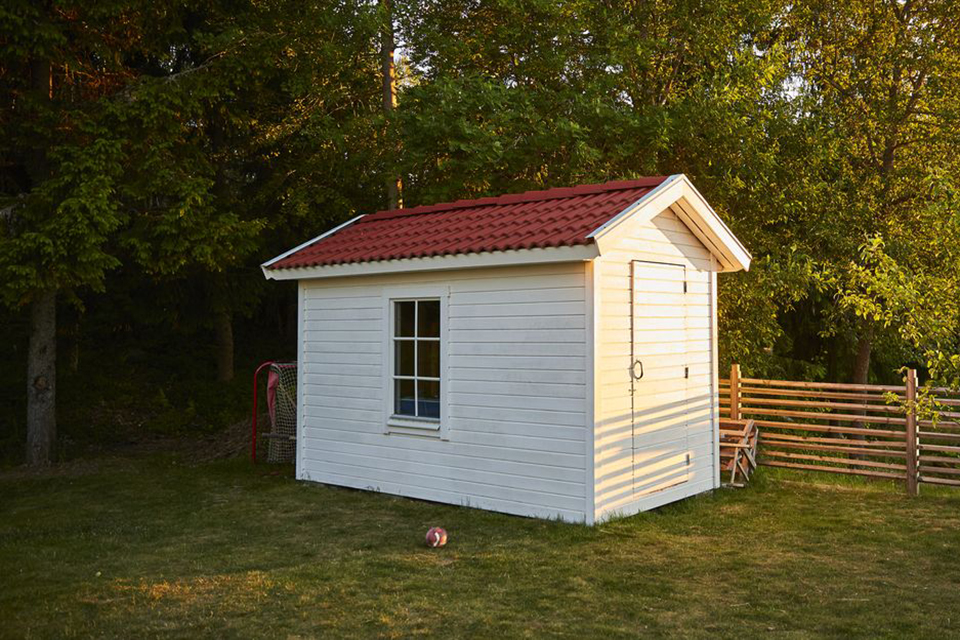How Much is a Garden Office?
Garden offices are now more popular than ever, however before you decide to build an office in your back garden, you need to think about how much it costs.
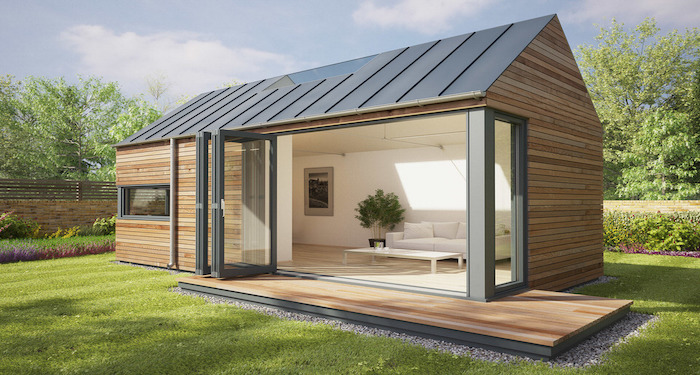
So, how much does a garden office cost?
Garden office costs are determined by size, location, and specifications, just like any other building.
For a budget garden office that is ready to put together, expect to pay roughly £1,000 - £2,000. These are available online, but most garden centres have models on display. The contrast in quality between the first and second options is obvious.
A purpose-built garden office costs around £9,000 - £10,000 on average. This type of garden office consists of a predetermined blueprint with the components delivered ready to assemble.
If you want a bespoke garden office, you may need to consider the additional costs of hiring an architect.
For a bespoke garden office, you can hire an architect to design your building specifically for your space, with a construction team sourcing the materials for you. This will raise the cost of your garden office, but you will be able to customise it to your exact specifications.
A brick garden office will set you back about £23,000 - £25,000. This could be a possible alternative if you have the room and are willing to go through the process of applying for planning permission. The benefit of this design is that it may be converted into a separate, self-contained dwelling at any time.
You also need to factor in the size of the garden office within the cost. For example, a tiny garden office can cost anywhere between £5,000 and £20,000, while a medium to a big garden office can cost anywhere from £12,000 to £20,000, depending on the quality of the construction and bespoke amenities.
A garden office is a great way to free up additional space in your home.
Are there any additional costs to consider?
If you get a building quote from a supplier or a contractor, don't forget to inquire about the cost of any foundations that will be needed.
You may also want to ask about the cost of plumbing and drainage for a shower or toilet if one is included. A toilet will often add between £1,000 and £2,000 to the final cost, while a shower room can cost up to £3,000.
Many companies also provide construction and painting services, but these usually come at an extra cost.
The average cost of a garden room will also vary depending on where you live. For instance, the cost of a complete and installed garden room in London starts at £15,000- £16,000.
The prices for a garden office installation tend to be higher in London than other areas of the UK.
In comparison, a complete and installed solution in area such as the North usually costs around £12,000 - £16,000 depending on the design and materials used.
Garden Office Prices 2024
To help you get a better idea of the costs, here is a breakdown of the average costs to build a garden office.
| Garden Office | Average Cost |
|---|---|
| A good build that is still off the shelf | £1,000-£2,000 |
| A purpose-built garden office | £9,000-£10,000 |
| Made with bricks garden office | £23,000 – £25,000 |
| Small garden office | £5,000-£20,000 |
| Medium/big garden office | £12,000-£20,000 |
| Garden office with toilet | Added £1,000-£2,000 |
- How Much is a Garden Office?
- What are the Supply Costs of Building a Garden Office?
- Additional Costs of Garden Office Construction?
- Tradesmen Costs for Building a Garden Office
- How Long Does It Take to Build a Garden Office?
- Types of Garden Office Cladding
- Benefits of a Garden Office
- How Much Does It Cost to Remove a Garden Office?
- FAQs
- Sources
What are the Supply Costs of Building a Garden Office?
If you are planning to build a garden room yourself, you will need to considering the supply costs.
The supply cost of a garden office will typically include the cost of the foundations may be included in the total cost of a garden room.
Garden offices, in most cases, will not require the same foundations as a house. Preparing a concrete slab base is the most usual procedure. It will cost roughly £1,500 - £1,800 for a small concrete slab base - around 2m by 2m - depending on ground conditions and ease of access, with prices increasing as the size grows.
Another typical option is to employ ground screws, which are dug to the desired depth into the dirt and then used as a base for the room's frame. These are especially effective where the ground isn't flat, and they have a lower long-term impact than a concrete foundation. Depending on the size of the device being built, a ground screw system can cost roughly £2,000 - £2,500.
When it comes to purchasing a garden room, there are several variables to consider:
- The size of the structure
- Whether you go with a modular or bespoke design, you'll be glad you did
- The construction system you select - high-quality SIPS or timber frames
- The finishes you select - cedar cladding and plastered interiors, for example - affect the price
- Bi-fold doors and air conditioning are two design features that will raise the price
Additional Costs of Garden Office Construction?
If you want your garden office to be luxurious, then you must be prepared for the cost of your garden office to increase.
For example, if you want it to be painted and decorated, you will end up paying more for a tradesperson to complete the work.
Below are some of the most common additional costs of garden office construction:
Electrics
You'll need to install electrics, including lighting and power plugs. This can be installed after the construction, but most modern garden office units come with built-in outlets and lighting fixtures, so you'll only need to connect to your home's electrical system.
Installing the cabling and ensuring it is safe will require the services of a competent electrician. For a typical-sized yard, the installation will cost between £600 and £1,000.

The final cost will be determined by the time spent installing electrical installations.
Insulation
If you want to spend a lot of time in your garden office, you'll want to make sure it stays at a comfortable temperature no matter what the weather is like.
Insulation is typically include on higher-end garden rooms made of timber frame or modular construction. However, the quality of the insulation will affect the final price of the unit. Many manufacturers will strive for insulation that is comparable to that found in homes.
The materials and installation of wall insulation will likely cost between £1,000 and £1,500, depending on the size of the room.
Installation usually takes around 1 – 2 hours to install the installation switches.
Windows and Doors
The type of windows and doors you use in your garden room will vary, ranging from less expensive uPVC frames to more expensive hardwoods.
Wall-to-ceiling windows that take up an entire side of the space, as well as bifold doors that open an entire side of the room to let the outside in, are quite popular. These can increase the entire cost by £2,000 to £3,000.
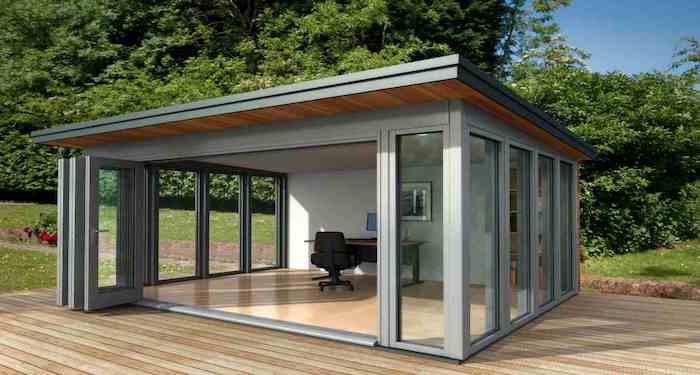
Painting and Decorating
When redecorating, you should think about how much interior painting will cost for various jobs.
Painting a room might cost anywhere between £180 for a small room and £600 for a large room.
You'll need to factor in the expense of painting and decorating other fixtures, such as skirting boards, which range from £180 to £350, and window painting, which costs between £400 and £1,500.
Other services include painting doors, which costs between £220 and £1,600 and re-painting kitchen cabinets which is typically priced anywhere from £600 to £1,000.
Wallpapering is another substantial decorating expense, costing around £180 for a small room and £600 to strip and hang the wallpaper, while internal cladding costs between £1,500 and £2,500.
New Floor Installation
The average cost of flooring installation is between £400 and £1,000 in most circumstances.
The cost of installing new flooring, on the other hand, will vary depending on the type of flooring you desire and the size of the room. To have a new floor installation it usually takes around 1 – 2 days for a hard wooden floor to be installed.
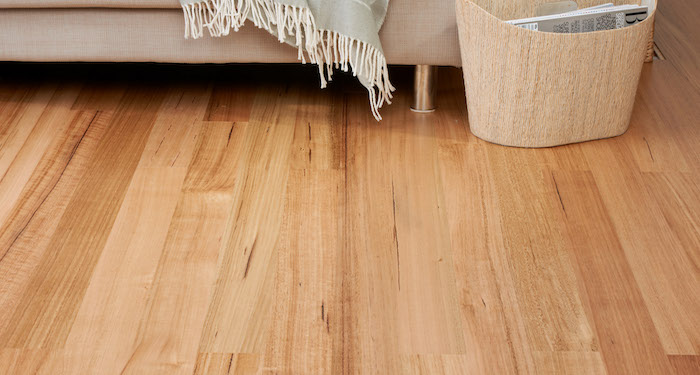
The table below will breaks down the additional costs of a garden office installation:
| Job | Average Cost |
|---|---|
| Average sized garden office electrics | £600 - £1,000 |
| Installation | £1,000 - £1,500 |
| Windows and doors | £2,000 – £3,000 |
| Painting | £180 - £1,600 |
| Wallpapering | £600 - £2,500 |
| New floor installation | £400 - £1,000 |
Tradesmen Costs for Building a Garden Office
The cost of hiring tradespeople to construct a garden office will cost roughly £170 to £190 per day on average. This assumes that a group of labourers will be on-site to build an outbuilding. However, depending on the sort of labourers hired and other considerations, labour costs can reach around £1,000 each day.
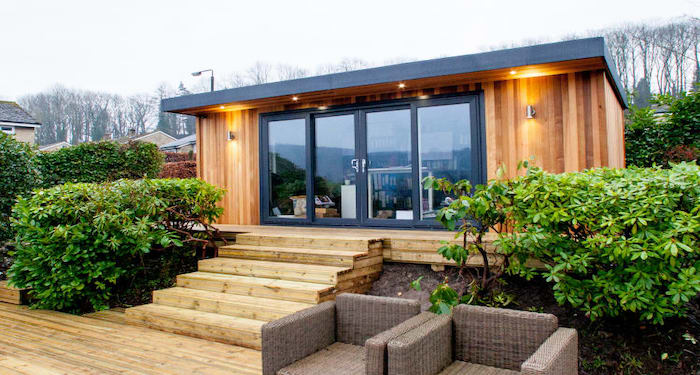
The labour cost could range from £275 to £325. The number of people employed for the project, the duration of the job, convenience of access, the state of the workspace, and your location in the UK are all factors that influence labour expenses.
| Job | Average Cost |
|---|---|
| Daily labour costs | £170 - £190 |
| Overall labour costs | £1,000 |
| Average labour costs | £275 – £325 |
How Long Does It Take to Build a Garden Office?
Garden office development is one of the most efficient construction methods available. This implies your new room can be constructed in a matter of days.
Most garden office suppliers will plan the manufacturing of your office within the weeks between your order and delivery. A garden office is often made up of a succession of smaller modules that may be easily assembled on-site.
Some garden office suppliers have vast workshops equipped with cutting-edge gear where they construct your office structure. Other businesses get all the components they want from several vendors and project manage the process so that everything is completed on location.
When the construction crew gets on site, work on your office will begin immediately. On-site construction teams usually consist of two to four people. The number is often based on the size and complexity of the building. Other tradespeople may be involved in the construction process if additional skill sets are necessary, such as electricians and plasterers.
It's worth noting that if you decide you want plastering or our acoustic pack, the process may take a few weeks longer to allow for the plastering to cure. Overall, the construction period is relatively quick, and the planning time is not much longer. Here are different timescales it will take to build your garden office.
Duration of Building a Garden Office
Some providers have perfected their processes and completed the main part of the construction in their workshops before getting on-site. This means they can build the structure in a day.
A small to medium modular garden office design typically takes 2 days to construct. On average, most garden office construction projects take 7 to 10 days to finish on-site.
There are also factors that may affect the timescale, such as painting, re-wiring and more. The table below sets out the average timescales of the different jobs involved in building a garden office.
| Job | Duration th> |
|---|---|
| Building a Garden Office | 2 - 10 days |
| Painting and decorating | 1 – 4 days |
| Electricity | 20 minutes – 2 days |
| New flooring | 3 hours – 4 days |
| Windows and doors | 1 hour – 4 hours |
Types of Garden Office Cladding
The cost of building a garden office will differ depending on the cladding material used.
A decent outside cladding for a garden office will not only keep the structure dry, but will also protect it against rot, insect, and fungal attack. It will be resistant to UV rays as well. Protection against these dangers will result in a finish that lasts longer and requires less upkeep.
Some cladding materials are naturally resistant to the dangers listed above. Others, on the other hand, can be easily protected.
Here are some of the most popular cladding options for a garden office:
Pine Cladding Cost
Fast-growing pine cladding, which is a honey colour in its natural state, is a type of entry-level timber cladding utilised on garden offices. It's easy to work with and can be utilised for a variety of cladding profiles.
Pine cladding requires UV protection as well as protection from rot, insect, and fungal attack. It is not a long-lasting cladding in its natural state.
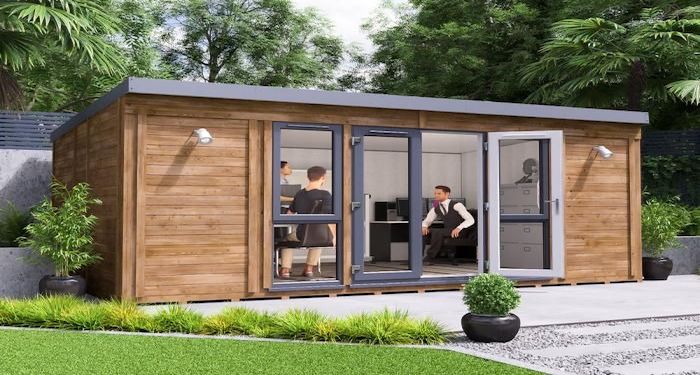
Pine cladding typically costs anywhere from £1 to £28 per board.
Pros:
- Easy to work with
- Cheapest option
Cons:
- Isn't as long-lasting as others
Thermowood Cladding Cost
Heat treatment, also known as Thermowood, is another preservation treatment for pine cladding. The wood is roasted to extremely high temperatures in this situation, which preserves it.
Garden offices with heat treated cladding are frequently left unfinished. They take them in stride and weather to a silvery hue over time. Thermowood weathering is more consistent than untreated pine weathering.
Many garden offices with wood siding are painted, which not only repels moisture but also provides a consistent colour. The grain and knots in softwood panelling can be 'busy' for some people, therefore the opaque finish of paint hides them.
Thermowood cladding is typically sold by the linear metre rather than by the square metre. Thermowood cladding ranges in price from £5.35 to £11.23 per linear metre.
Pros:
- Long life span
Cons:
- Hard to finish the job
Cedar Cladding Cost
When it comes to garden office cladding, western red cedar is by far the most popular choice. This is because it is a dimensionally stable wood with inherent insect and fungus resistance and, in most cases, does not require a decorative treatment.
Cedar begins as a reddish-brown colour, but with time and exposure, it takes on a silver hue. While the silver looks great, it will have quite a different appearance from the new structure.
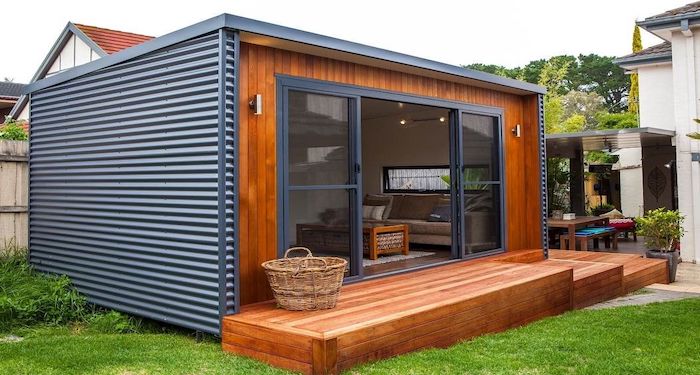
If you choose to apply an oil that protects against UV rays during the design stage, you can keep the natural redness. This is something that should be done before the wood is exposed.
Prices for cedar cladding start at £30 per m2 and go up to £65 per m2 for face fix 18 x 144mm profiles.
Pros:
- Aesthetically pleasing
- Easy to keep the natural redness if preferred
Cons:
- Expensive option
Siberian Larch Cladding Cost
The innate resilience of Siberian Larch makes it a great choice for garden office cladding. This is due to the resins in the wood, which make it rot and fungus assault resistant. Larch will deteriorate to a silver-grey colour if left untreated. The obvious knots in the larch sheathing provide character to the structure.
Siberian larch is widely used as garden office cladding, but Scottish larch is a better option if you want a product that is cultivated and sourced in the UK.
If you're constructing an eco-friendly garden office, this is a particularly appealing alternative because it has a lower carbon impact than other cladding options.
Cladding made of Siberian Larch costs around £50 per square metre.
Pros:
- Popular choice
- Rot and fungus resistance
Cons:
- Must be maintained
Exterior Grade MDF Cost
A few businesses employ exterior grade MDF products for their building's cladding. People sometimes assume that MDF is an interior product that will not withstand the rigours of outside use. However, because of the resins used in its manufacture, external grade MDF is quite robust.
MDF is an excellent cladding material since it comes in huge sheets with few joints. Although unfinished exterior grade MDF has a green tinge, its smooth surface is ideally suited to paint finishes.
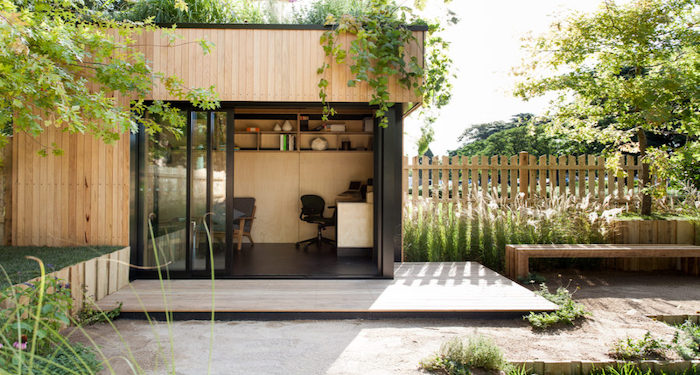
Exterior grade MDF sheets costs around £20 - £40 per metre.
Pros:
- Smooth finish
- Easy to do
Cons:
- None
Benefits of a Garden Office
In the past year, working from home has become the norm. By building a garden office, you can create the perfect work environment that is also close to your home comforts.
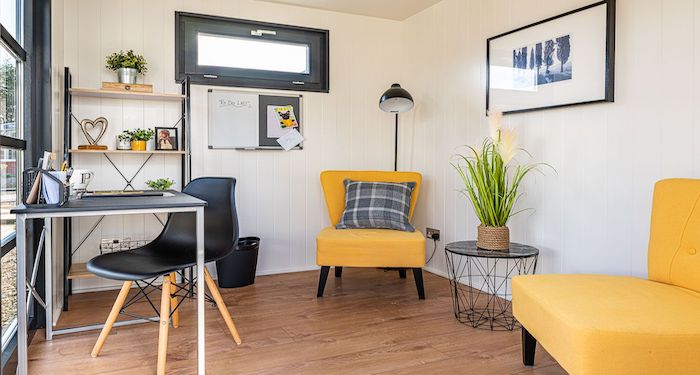
There are a wide range of benefits for building a garden office, including:
No Daily Commute
Your commuting time can be drastically reduced if you set up your workplace in your yard. There will be no more early mornings to beat rush hour traffic or frantic public transportation where you will struggle to find a seat.
A short walk from your back door to your garden office will allow you to start your day relaxed and stress-free, not to mention the money you will save.
No More 9 – 5
Gone are the days when you had to make sure you were at your desk by 9am and didn't leave until 5pm. Having an office in your yard allows you to work the hours that are most convenient for you.
You'll be able to do what you need to do inside your work hours, without having to adhere to the prescribed hours of business offices if you have the correct mindset.
Away from the City
If you work in a city, the hustle and bustle of the busy environment can have an impact on how you work, and it isn't for everyone. When you work in your garden office, you may find that the serene and peaceful atmosphere boosts your productivity.
Create your Workspace
Another advantage of working from your garden office is the option to build a workspace that meets your needs. Being able to choose your desk, chair, and even the room's temperature are all advantages of having your own garden workspace.
Balance Home and Work-Life
It can be tough to find the perfect balance between home and work life but working from your garden could be the solution. By building a practical garden office this will ensure that your time management improves, so you can enjoy things outside of work.
Working from your garden office will allow you to take more breaks, see your child's school performance, or cook dinner for the family while still working.
Increases Property Value
Not only is having a garden office advantageous to your lifestyle but having additions in your house, such as a garden office, can enhance the value of your home by up to 7% when it comes to moving on and selling up.
Purchasing an outdoor structure might be a potential financial source by the time you decide to relocate, so it's something you should think about.
How Much Does It Cost to Remove a Garden Office?
The typical cost of removing a garden office is between £500 and £2,500. The cost will, of course, be influenced by the outbuilding's size and type, as well as its shape and structural complexity.
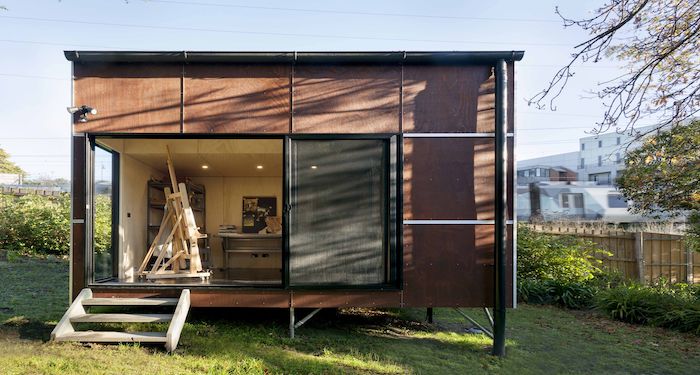
Because some materials are easier to remove/disassemble than others, this will influence how much it costs to remove them.
FAQs
Q: How to get Wi-Fi in a garden office?
A: A Wi-Fi extender is a simple piece of technology that connects to your existing Wi-Fi network and expands the signal. The router and extension work together to bridge the space between your home's primary router and your garden office building.
To establish a strong and steady connection in all the surrounding regions, plug the extender into a mains socket in your home. It's ideal to find a spot halfway between the router and the garden office.
Q: How do you convert a garden outhouse into an office?
A:
- To begin, start thinking about how you want your office to look. Make two lists: one explaining what you'll do with your workplace (uses) and the other outlining what those uses will necessitate (requirements)
- Plan the layout of your office, experimenting with different configurations to fit all your requirements into the available area
- Check the condition of your current shed, as well as the location you've picked, to determine if any maintenance issues need to be addressed before the conversion begins
- Once the shed is ready, begin the conversion by thoroughly damp proofing it
- Install insulation in the shed's floors, ceiling, and walls
- Install electricity in the shed, either from the mains or from a generator (wind or solar)
- Install the lighting of your choice (lamps, fluorescents, halogen or LED lights)
- Install heating that is standalone, wall-mounted, or underfloor.
- Tethering, Wi-Fi, or a powerline adaptor can all be used to connect your shed to the internet
- Install a water butt and guttering system or run water from the mains to your shed
- Make sure your shed's contents are safe
- Decorate your workspace to suit your preferences
Q: Do you need planning permission to build a garden office?
A: Most of the time, you won't need planning permission for your garden office. You can extend your property without obtaining planning permission or building regulations approval, so you can swiftly and cost-effectively install your garden office, saving money, time, and stress.
Q: How much space do you need for a garden office?
A: If possible, your garden office or garden room should have at least 18" of free space on all sides. This allows for quick installation as well as future maintenance. In practice, this is rarely feasible, and it is not required at many places. On one or both sides, a reduced clearance is frequently attainable.
Q: Do garden offices last?
A: Garden offices are built to last for decades with minimal annual upkeep. External finishes are chosen for their long life expectancy; roof coverings and claddings are expected to last 25 years or more.
Sources
- https://www.thegardenoffice.co.uk/how-much-does-a-garden-office-cost/
- https://aroominthegarden.co.uk/garden-office-options-for-every-budget/
- https://www.gardenofficeguide.co.uk/how-long-will-it-take-to-build-an-office-in-my-garden/
- https://northernlifemagazine.co.uk/why-having-a-garden-office-is-beneficial/
- https://www.solidsheds.com/blog/how-get-wifi-garden-office/
- https://www.waltons.co.uk/blog/how-to-turn-shed-into-office

